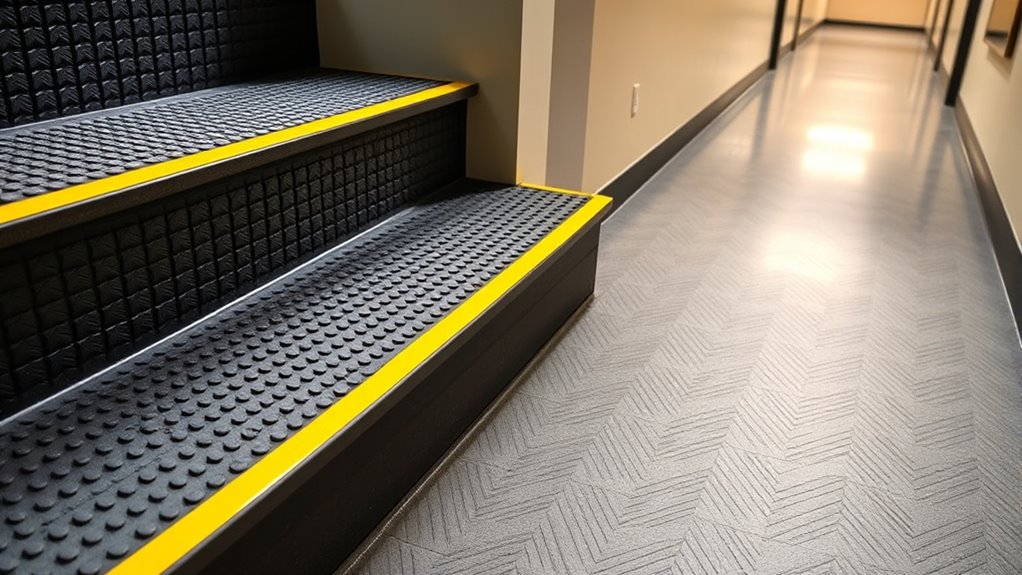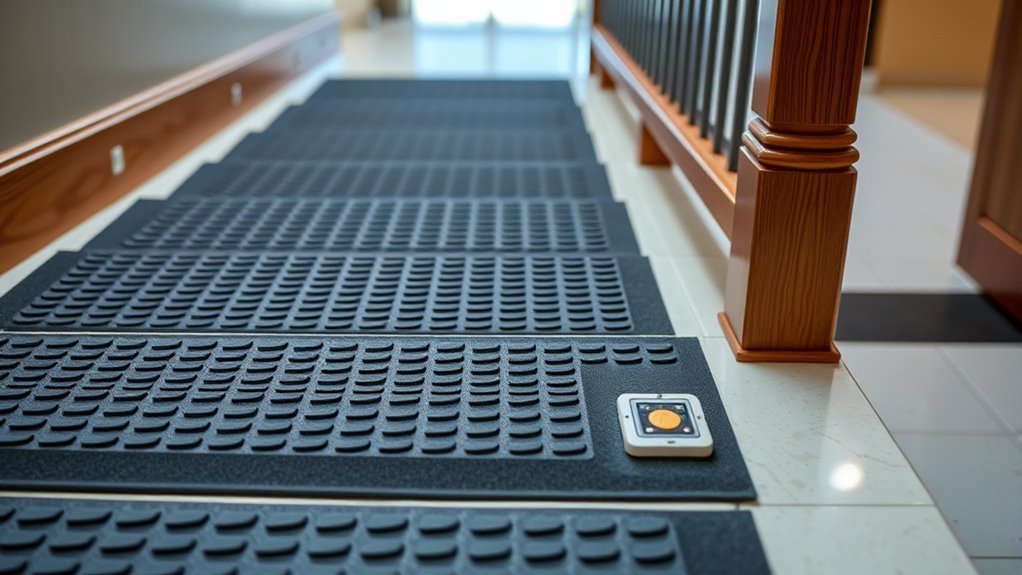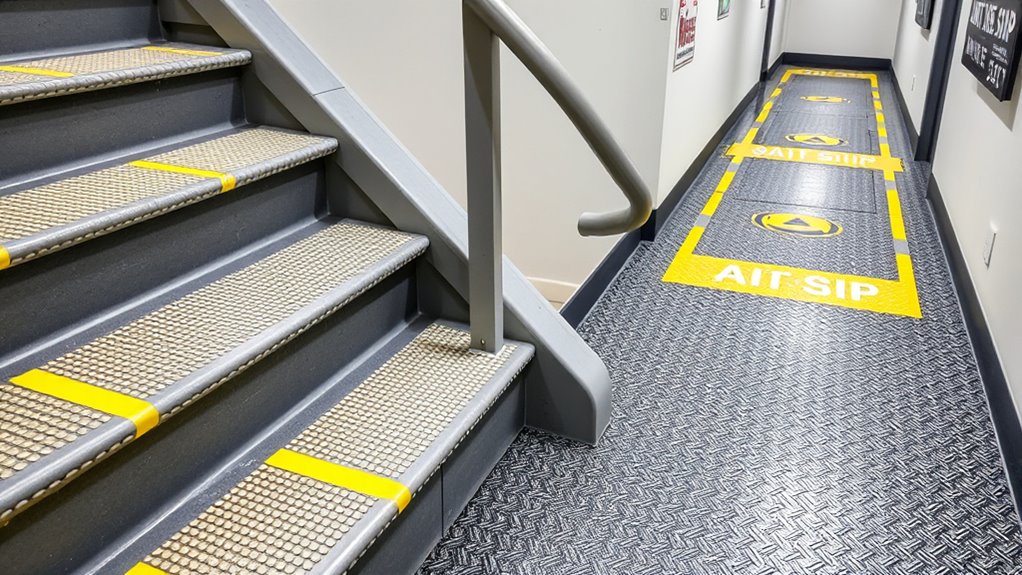Slip-resistance standards for stairs and hallways set safety thresholds, guaranteeing surfaces provide adequate grip to prevent falls. Regulations like ASTM F2508 and ANSI B101.3 specify minimum friction coefficients tested with specialized equipment under conditions like moisture and wear. Choosing the right materials, incorporating textured surfaces, and regular maintenance help meet these standards. To learn more about how to ensure your spaces stay safe and compliant, keep exploring the key methods and best practices.
Key Takeaways
- Standards like ASTM F2508 and ANSI B101.3 specify minimum slip resistance coefficients for stairs and hallways.
- Testing methods involve tribometers to measure the coefficient of friction under simulated environmental conditions.
- Regulations require regular inspections and maintenance to ensure ongoing compliance with slip-resistance standards.
- Material choices, such as textured surfaces and slip-resistant coatings, are guided by these safety standards.
- Design guidelines recommend proper stair tread dimensions, adequate lighting, and signage to minimize slip hazards.
Understanding Slip-Resistance Testing Methods

Understanding slip-resistance testing methods is essential for ensuring safety on various surfaces. You’ll want to focus on coefficient measurement, which quantifies how slip-resistant a surface is. Testing protocols are standardized procedures that guarantee consistent and accurate results. These protocols often involve using specialized equipment, such as tribometers, to simulate foot traffic and measure resistance levels. By following established testing methods, you can accurately assess if a surface meets safety standards. It’s important to understand how different conditions—like moisture or wear—impact the results. Proper testing helps identify surfaces that may pose slip hazards, allowing you to make informed decisions about repairs or treatments. Additionally, understanding slip-resistance standards and how they are developed helps ensure compliance with safety regulations. Staying current with industry trends and testing technologies can further improve safety assessments. Advances in digital testing methods provide more precise and repeatable measurements. For example, incorporating wear and environmental factors into testing procedures ensures a comprehensive evaluation of slip resistance. Ultimately, these methods serve as a foundation for creating safer environments in stairs, hallways, and other high-traffic areas.
Key Regulations and Standards for Slip Resistance

To guarantee safety in various environments, several key regulations and standards set the minimum slip resistance levels surfaces must meet. Historical slip resistance cases have highlighted the importance of adhering to these standards, prompting updates to safety regulations. Regulations like ASTM F2508 and ANSI B101.3 specify testing methods and minimum coefficient of friction values for stairs and hallways. Cultural safety perceptions influence these standards, reflecting societal expectations for accessible, hazard-free spaces. Standards evolve as new research emerges and incidents occur, emphasizing the importance of compliance. By understanding and following these regulations, you help reduce slip accidents and create safer environments that align with current safety expectations and historical lessons. Staying informed ensures your surfaces meet or exceed these critical safety benchmarks.
Selecting Appropriate Slip-Resistant Materials and Surfaces

Choosing the right slip-resistant materials and surfaces is essential for ensuring safety in any environment. To achieve this, consider these options:
- Use innovative coatings that provide enhanced grip while resisting wear and tear. These coatings can be especially effective when applied to high-traffic areas to maintain slip resistance over time.
- Opt for surfaces with aesthetic textures that improve traction without sacrificing style.
- Select materials like textured rubber or treated concrete for stairs and hallways. These materials are known for their durability and ability to provide reliable grip.
- Balance durability with visual appeal to create safe, attractive pathways.
- Incorporate slip-resistance standards that prioritize health-conscious consumers, which can be relevant for environments promoting wellness and safety. Understanding material properties from Hyundai Tuning can inform choices that enhance both performance and safety in surface design.
Implementing Slip-Resistance Measures in Design and Construction

You need to focus on selecting the right materials and ensuring construction quality to effectively implement slip-resistance measures. Proper material choices and strict quality assurance help maintain safety standards throughout the project. By prioritizing these points, you can create surfaces that are safe and durable for users. Additionally, understanding the horsepower of electric dirt bikes can inform the selection of high-traction surfaces capable of supporting increased speeds and power outputs. Incorporating vetted materials with proven slip-resistance properties is essential for long-term safety and compliance with standards. Regular assessment and organization of the installation process can further enhance safety and durability over time, especially when considering the specific knitting patterns for sweaters that may influence surface design and texture.
Material Selection Strategies
Selecting the right materials is essential when implementing slip-resistance measures in design and construction, as it directly impacts safety and durability. To optimize your choices, consider these strategies:
- Assess footwear compatibility to ensure materials provide traction across various shoe types.
- Balance slip-resistance with aesthetic considerations, choosing textures and colors that match your environment.
- Prioritize durable materials like textured rubber or treated concrete for high-traffic areas.
- Test samples for slip resistance under real-world conditions before final installation.
- Recognize the importance of emotional alignment in ensuring consistent safety practices among team members involved in installation and maintenance.
- Incorporating regular maintenance ensures that slip-resistance measures remain effective over time, preventing hazards caused by wear and debris buildup.
- Staying informed about regulatory standards is critical to ensure that selected materials meet current safety requirements and industry best practices.
- Understanding the benefits of raw food can inspire the integration of natural, textured surfaces that enhance grip and safety in design.
Construction Quality Assurance
Effective construction quality assurance guarantees that slip-resistance measures are properly implemented and maintained throughout the project. You should verify that coatings are applied correctly to ensure coating durability, preventing premature wear that could compromise slip resistance. Regular inspections during construction help identify issues early, allowing you to address problems before they affect safety. Pay attention to aesthetic considerations, making sure coatings blend seamlessly with design elements while maintaining slip-resistant properties. Document all procedures and results to ensure accountability and facilitate ongoing maintenance. By adhering to strict quality assurance protocols, you ensure that slip-resistance measures remain effective over time, providing consistent safety for stairs and hallways. Incorporating quality standards aligned with industry best practices can further enhance the reliability of slip-resistance implementations. Implementing testing procedures during construction can help verify that the slip-resistance levels meet safety requirements. Conducting comprehensive inspections ensures that all aspects of slip-resistance are thoroughly evaluated throughout the project. Proper QA ultimately guarantees that safety standards are met without sacrificing visual appeal. Additionally, referencing support hours can help coordinate inspections and maintenance schedules efficiently.
Maintaining and Monitoring Slip Resistance Over Time

To guarantee slip resistance remains effective, you need to regularly test your surfaces and check for any signs of wear. Over time, foot traffic and environmental factors can reduce traction, making ongoing monitoring essential. Addressing these issues promptly keeps your surfaces safe and compliant with standards. Incorporating security lighting can also enhance visibility and safety during nighttime use. Additionally, using appropriate cleaning methods helps maintain the surface texture and slip resistance properties over time. Regular inspections can help identify wear and tear, ensuring proactive measures are taken before hazards develop. Being aware of factors affecting slip resistance can further aid in maintaining safety standards effectively.
Regular Testing Practices
Regular testing is essential to guarantee slip resistance remains effective over time. To make certain your stairs and hallways stay safe, consider these practices:
- Schedule routine inspections using slip resistance testers to identify changes.
- Use innovative coatings that enhance slip resistance and provide additional slip enhancement.
- Track surface conditions regularly, especially after cleaning or weather events.
- Adjust maintenance protocols based on test results, applying slip-resistant treatments as needed.
Wear and Tear Effects
As surfaces experience constant foot traffic and environmental exposure, wear and tear gradually diminish their slip resistance. Surface degradation occurs as the material wears down, creating smoother areas that are more prone to slipping. Contamination effects, such as dirt, oil, or moisture buildup, further reduce grip, making surfaces slicker over time. Regular monitoring helps identify these changes before they become hazards. You should inspect high-traffic areas frequently and clean surfaces promptly to remove contaminants. Applying slip-resistant coatings or treatments can restore traction, but only if you stay vigilant about ongoing wear and contamination. Understanding how surface degradation and contamination effects impact slip resistance allows you to maintain safer stairs and hallways, ensuring they remain slip-resistant despite ongoing use.
Best Practices for Ensuring Safety in High-Risk Areas

Ensuring safety in high-risk areas requires implementing best practices that minimize slip hazards and protect workers. First, apply anti-slip coatings to surfaces prone to moisture or spills, enhancing grip. Second, prioritize proper stair tread design, ensuring treads are wide enough and have consistent height to prevent missteps. Third, regularly inspect and maintain flooring, replacing worn or damaged anti-slip coatings promptly. Fourth, install clear, visible signage and lighting to alert workers to potential hazards and improve visibility. These measures work together to reduce slip risks and create safer pathways. By focusing on effective stair tread design and applying anti-slip coatings where needed, you can considerably decrease accidents and foster a safer environment in high-risk zones.
Frequently Asked Questions
How Often Should Slip Resistance Be Re-Evaluated in Public Buildings?
You should re-evaluate slip resistance regularly to guarantee safety. Typically, maintenance schedules recommend testing procedures every six months to a year, depending on traffic and usage. After cleaning, weather changes, or any incidents, it’s wise to conduct additional assessments. Consistent testing helps identify wear or hazards early, so you can address issues promptly and keep stairs and hallways safe for everyone, maintaining compliance and preventing accidents.
Are There Specific Materials Recommended for Outdoor Stairs in Wet Climates?
Think of outdoor stairs in wet climates as a river steering rocky terrain. You should choose durable outdoor paving materials like textured concrete or stone that naturally grip shoes. Applying anti slip coatings acts like a sturdy boat, keeping you afloat despite the slippery conditions. These materials and coatings ensure safety, preventing slips and falls, especially when weather turns wet and unpredictable. Always select options designed for moisture-rich environments to keep everyone safe.
What Are the Cost Implications of Upgrading to High-Grade Slip-Resistant Surfaces?
When you consider upgrading to high-grade slip-resistant surfaces, you should do a thorough cost analysis, factoring in material selection and installation costs. While premium materials may be more expensive initially, they can reduce long-term maintenance and safety risks. You’ll need to weigh the upfront investment against potential savings from fewer accidents and repairs, ensuring the upgrade aligns with your safety standards and budget constraints.
How Do Weather Conditions Affect Slip Resistance Standards Compliance?
Imagine weather variations transforming your stairs into ice rinks overnight! Weather conditions directly impact slip resistance standards compliance by challenging surface durability. Rain, snow, or ice can drastically reduce grip, making surfaces more slippery than ever. You must regularly assess and adapt your flooring to maintain safety. Ignoring these changes risks accidents, so stay vigilant, upgrade surfaces when needed, and guarantee your stairs and hallways remain slip-resistant no matter the weather.
Can Existing Stairs Be Retrofitted to Meet Current Slip-Resistance Standards?
You can definitely retrofit staircases to meet current slip-resistance standards. By installing slip-resistant treads, applying specialized coatings, or adding anti-slip strips, you improve safety quickly. These slip resistance upgrades are effective and often straightforward to implement, especially on existing stairs. Regular maintenance and selecting proven slip-resistant materials guarantee your staircase remains safe year-round, giving you peace of mind without the need for complete reconstruction.
Conclusion
By choosing the right materials and regularly maintaining slip-resistant surfaces, you can prevent accidents and save lives. While standards set the baseline for safety, your proactive approach guarantees true protection. Slip resistance isn’t just about compliance—it’s about caring for every person who steps into your space. When you combine vigilant monitoring with thoughtful design, safety becomes seamless, not just a requirement. Ultimately, your commitment transforms hazards into secure, confident pathways.








